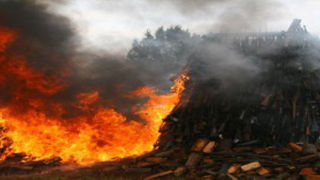
An assortment of ammunition goes up in flames on March 24, 2010 during a public destruction of 2,545 illicit firearms recovered by Kenyan security forces.
| Joan Pereruan | Nation Media GroupWeekly Review
Premium
Kenya tops East African region's crime index
Human trafficking, arms trafficking, environmental crime, drug trafficking and cybercrime have placed Kenya at the top in the region’s crime index.
According to the Africa Organised Crime Index 2023 by Global Initiative-Transnational Organised Crime (GI-TOC), which was funded by the European Union (EU), there is increasing criminality and growing vulnerability of societies owing to the evolving nature of the crimes.
Research data revealed that Kenya scores 7.02 in the criminality index, leading the nine Eastern Africa region states and fourth among the 54 nations on the continent. The score is 0.07 points higher than the previous year’s.
In the resilience score, which indicates the ability to fight criminality, Kenya scored 5.33, up 0.13 points from last year, showing that there have been continued efforts to combat the problem in the country.
Most of the noted crimes are being executed in collusion with senior public officials and corrupt politicians, making it harder for law enforcement to intervene.
According to the report, human trafficking, arms trafficking, cannabis trade, financial crimes and cybercrimes showed a notable increase. Electoral tension, political instability and conflict, the Kenya report noted, have significantly contributed to the increased criminality in the country. It further indicates that the gap between criminality and ability to combat it has greatly increased.
Kenya, Nigeria and South Africa, which are some the continent’s biggest economies, bore the brunt of increased criminality following elections.
According to EU Deputy Head of Delegation to Kenya Ondrej Simek, the impact of the increasing criminality on security and governance is profound.
“In Africa, we don’t really see anything getting better because the criminal actors seem to have a special affinity for the continent. The EU has been committed to supporting resilience efforts, and organised crime is a priority for intervention in line with the EU’s roadmap in fighting drug and human trafficking. EU will continue to support African efforts in combating effects of organised crime,” Mr Simek said.
GI-TOC Director Mark Shaw revealed that criminal actors are embedded in the private sector and noted that criminal spheres have grown from last years’ 10 to the current 15, turning the region into the criminals’ playground.
The report reveals that criminal gangs and corrupt public officials in Kenya largely operate with impunity and offer protection to drug lords and corrupt politicians.
Kenya scored high for human trafficking aimed at forced labour and sexual exploitation because of its geographical position, which is favoured by traffickers.
New hotspots have emerged around the country in recent years, with human smugglers transporting illegal immigrants from Somali, Eritrea, Uganda and Tanzania to the Gulf States and Middle East.
Because of its porous borders and regional position, Kenya has also become a hub for arms trafficking, which has exacerbated cattle theft.
“Decades-long armed violence in neighbouring Somalia has exacerbated the arms trafficking market in Kenya. In 2021, increased insecurity in Ethiopia resulted in an uptick in the number of firearms crossing the border. High level political and government officials are reportedly linked with trafficking arms to warring factions,” the report reveals.
There is also a noted increase in trade in counterfeit goods, especially car spare parts, electronics, luxury goods, fashion clothes and computer accessories, leading to billion shilling losses annually.
Illicit logging and harvesting of protected species also had a noted increase as the country’s forest cover dwindles. Wildlife trafficking between Kenya and Asia has remained prevalent. Trade in lion, rhino, hippo, sea cucumbers, turtle products, lobsters and donkey skins to China has risen to concerning levels. These illicit goods from the East African region are transported through the Port of Mombasa.
Minerals from the Democratic Republic of Congo are smuggled through Kenya to legitimise them, before they are sold to other countries as Kenyan products. These mineral smugglers, the report indicates, have associations with Kenyan politicians.
It further notes that although Kenya remains a transit point for drug trafficking, there has been significant rise in abuse of cocaine and heroin in the country. There is also growing domestic expansion of the use of synthetic drugs.
“Kenya is a transit country for heroin trafficked from Afghanistan and the Arabian Gulf to Europe, the Americas and other parts of Africa. Currently, there is a large domestic heroin and cocaine abuse problem, particularly along the coast. The heroin market is quite profitable and competitive and no special criminal group controls the trade.
“Authorities have pointed out that Kenyan drugs traffickers are now importing narcotics mainly for the local market, which if the trend continues, would transform Kenya from a drug transit hub to a consumption hub,” the report reveals.
Cybercrimes such as data breaches and ransomware have doubled in Kenya, the report shows, targeting insurance firms, schools, government organisations, public infrastructure, utility service providers and financial institutions.
The index also shows that that there has been an increase in financial crime across public and private sectors and civil society, with high levels of corruption among government officials and executive office holders leading to financial fraud, embezzlement and misuse of funds.




